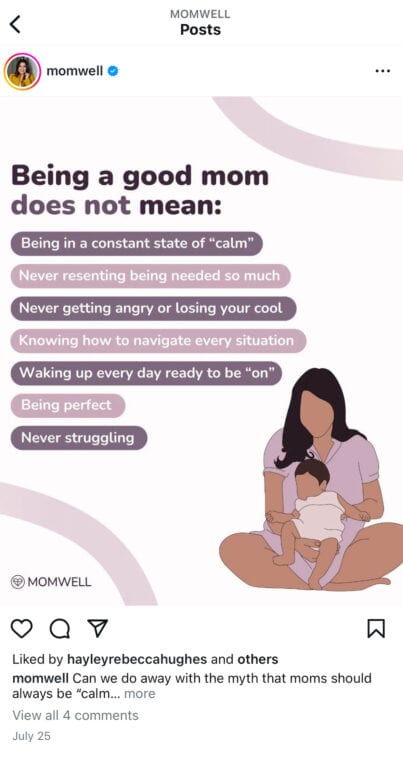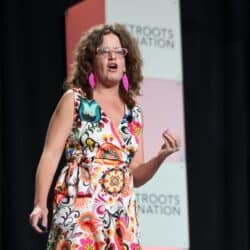What can we do to capture attention and meaningfully shift the mindsets on our issues? And how can we do that in a way that prioritizes shifting narrative power to the groups affected by the issues we’re talking about? With a rising number of organizations engaging with narrative change and sharing learnings, more ways of thinking about and approaching the work are emerging.
The question everyone was talking about was one that campaigners, activists, and communications strategists ask themselves a lot these days: How can we capture people’s attention without resorting to outrage-baiting? How can we compete with narratives that stoke anger and fear?
The people asking the question included members of Artists for Real Climate Action; The Goose Media; Sean Devlin, the founder of Shit Harper Did; the Small Change Fund; and Trottier Family Foundation. They’d assembled as part of a pilot project funded by Trottier called Comedy for Climate, whose aim is to create content and campaigns on climate issues that can break through hopelessness and disinformation and mobilize people to action.
It would take more than business-as-usual communications to cut through our polarized and hypercharged communications environment where facts have little currency and amplification is driven by outrage. “Blah blah blah” moments — Greta Thunberg’s simple and resounding indictment from the 2021 Youth4Climate Summit — become memes immediately, but what do they achieve?
The group talked about different narrative strategies that can dislodge apathy and cynicism and wake people up: debunking and myth-busting, humour, and satire. “We need to preach to the choir and get them to sing our message,” someone said. Others disagreed: the choir was converted already, why focus on them? “The choir is the choir because they have strong voices. They just need stronger sheet music,” someone replied.
Giordano Nanni, founder of The Juice Media, the Australian company behind the satirical Honest Government Ads video series, listened from the corner of the room. The series is an example of content that has broken through: each video exposes the Australian government’s hypocrisy and inaction on a range of climate issues, earning millions of views. The videos are scathing and cathartic – they’re effective because they say what viewers wish someone in power would. “I could block a road or bomb a dam. But this is what I felt I could do,” Nanni says.
There’s an urgent need to resource narrative-power-shifting work because non-progressive movements have been doing that work and building that infrastructure for years. We’re at a crisis moment on so many issues.
Mandy Van Deven, co-author of “How to Fund Narrative Ecosystems”
Many non-profits and foundations are asking themselves this question: What can we do to capture attention and meaningfully shift the mindsets on our issues? And how can we do that in a way that prioritizes shifting narrative power to the groups affected by the issues we’re talking about?
“There’s an urgent need to resource narrative-power-shifting work because non-progressive movements have been doing that work and building that infrastructure for years. We’re at a crisis moment on so many issues. And we’re in a paradox because what is needed is slow work, but we need it now,” says Mandy Van Deven, who works with foundations on narrative change initiatives and recently co-authored a piece in Nonprofit Quarterly about funding narrative change.
Van Deven points to a lack of understanding and expertise in the philanthropic and charitable sectors as a barrier. “The lack of grounding that most folks in philanthropy have in basic concepts around how do you shift people’s mentalities and how do you alter people’s behaviours is standing in the way of the resourcing being anywhere near adequate for what these funding institutions want to achieve.”
For those who are engaging with this work, many questions arise: What’s the role of foundations and philanthropy in funding narrative change and movement-building? Which investments have the most impact? What does effective convening look like? How do we measure change?
With a rising number of organizations engaging with narrative change and sharing learnings, more ways of thinking about and approaching the work are emerging. Among them: being willing to do things differently, funding knowledge generation and sharing that, and building ecosystems and infrastructure.
Forget business as usual
The way we engage with information and each other has undergone seismic shifts, transformed first by social platforms and their impact on politics, media, and basically everything in our lives, and now by AI, which posits a new version of reality and interacting with the world that we can’t ignore. Individuals and organizations working on politicized issues including climate and identity face an existential situation where facts and conversation are needed more than ever but are harder and harder to access.
Our own biology also works against us. In his book Our Tribal Future: How to Channel Our Foundational Human Instincts into a Force for Good, evolutionary anthropologist David R. Samson writes that we’re hardwired to privilege beliefs and opinions that cement our belonging to our tribe – whether or not those beliefs are true. In other words, our self-preservation instincts lend themselves well to supporting polarization. It’s an evolutionary adaptation that’s mismatched to our current needs and reality, and one that those working to shift mindsets need to keep in mind.
We tend to always land on the rationale that we need to use logic, we need to be reasonable . . . But others are going in the opposite direction. They’re using fear and aren’t using facts.
Jean-Patrick Toussaint, Trottier Foundation
To communicate effectively in this environment, we need to leave business as usual behind. That’s what drove the Trottier Family Foundation to kick-start its project. “We tend to always land on the rationale that we need to use logic, we need to be reasonable. If people understand the science, then they’ll really understand. But others are going in the opposite direction. They’re using fear and aren’t using facts. We felt like we needed to do things a little bit differently,” says Jean-Patrick Toussaint, senior climate director at the foundation. “We’d all watched the Juice Media videos and thought, ‘This is so clever.’ They have millions of views and they’re talking about carbon storage and carbon offsets. But the way they address those issues is completely different from the charitable sector.”
The creators in the pilot project have been trying different approaches to reach new audiences. The Goose Media, whose tagline is “Satire and ideas for a better Canadian future,” has produced TikTok videos on everything from the oil sands to carbon credits. The work led to The Climate Breakdown, a series of videos by the Weather Network about climate change’s impacts on weather.
Doing things differently has meant being okay with not controlling the narratives and content that’s being created as part of the project, being flexible about projects evolving in response to audience engagement, and not having a clear measurement strategy at the start. Toussaint and foundation executive director Éric St-Pierre are comfortable with that because it’s allowing them to learn and experiment without too many expectations. “We’re big believers in taking risks and innovating.”
For Inspirit Foundation, thinking differently about its funding strategy and how it could support narrative power building started in 2019. “[We were interested in] moving from small individual initiatives, where there was really good work being done, to thinking about what could be bigger, what was systemic? That’s when we first started to have conversations about narrative change and narrative power,” CEO Sadia Zaman says.
Many communities, especially communities of colour and racialized communities, don’t want to define themselves in response to the existing narrative.
Sadia Zaman, Inspirit Foundation
In 2021, Inspirit launched a Narrative Change Lab that brought together a dozen Muslim content creators working in the slipstream of pop culture to reimagine Muslim narratives. “Many communities, especially communities of colour and racialized communities, don’t want to define themselves in response to the existing narrative,” Zaman says. “Creatives are in the best position to be amplifying, creating, and reimagining those stories. We chose pop culture because we did not want this to be an academic exercise.”
Inspirit’s funding strategy is now focused on three streams of building narrative power: the past, the present, and the future. They’re supporting the Muslims in Canada Archives, which aims to reverse the erasure of Muslims from the historical narrative in Canada; building partnerships that challenge Islamophobia today, including one with the Béati Foundation that’s supporting community leaders to develop responses that challenge Islamophobia and create alternative narratives; and investing in infrastructure and ecosystem-building to resource the work into the future.
There was a real feeling of this idea of transformative change and wanting to pursue transformative approaches, transformative thinking. I think narrative is a part of that.
Vani Jain, Daymark Foundation
The Daymark Foundation has built narrative change into its approach from the start. The foundation aims to transform the way Canadians address mental health, including maternal mental health. CEO Vani Jain says the foundation started with an understanding that part of its work involves shifting beliefs. “There was a real feeling of this idea of transformative change and wanting to pursue transformative approaches, transformative thinking. I think narrative is a part of that.”
Jain says that common narratives and beliefs about motherhood – that a mother’s worth is defined by how much she sacrifices for her child, that women should fall in love with their child as soon as they’re born – butt up against what science tells us, which is that a mother’s mental health is the single greatest determinant of their child’s physical and mental health, and stand in the way of mothers getting the care and support they need.

“We’re really thinking about how to shift those narratives, and how we can make it easier for women to talk about these experiences,” Jain says. The foundation is funding a study on the therapeutic benefits of psychoeducation provided through social media on maternal mental health, looking at accounts run by trained therapists and people with lived experience who are using social media as a platform to question accepted narratives of motherhood and maternal mental health.
Reimagining the world as one that prioritizes and supports maternal mental health and convening and connecting partners to build it is the foundation’s work. Jain imagines a more nurturing online world where a mother-to-be googles a crib and is served ads about maternal mental health alongside links for cribs – an idea she and her team recently spoke to Google about.
It may seem like a small thing. But if you know, as the anthropologist David R. Samson and many campaigners do, that every communication and conversation is an opportunity to develop our ability to think critically about our preconceived notions and shift our mindsets, then the more exposure opportunities we create, the likelier we are to succeed.
Deepening our understanding of how people think
In the quest to shift mindsets, we accumulate lots of data points on opinions. Polls, social media comments, and media interviews tell us what people think, but they often don’t tell us how people form their beliefs about issues, and how those beliefs and mindsets change over time.
FrameWorks UK is trying to bridge that gap. Working with non-profit partners, the organization has identified three crosscutting mindsets that prevent change on the issues its partners work on: individualism, fatalism, and othering. In a one-year pilot project funded by The Health Foundation and the Joseph Rowntree Foundation, FrameWorks is running a series of quantitative and qualitative surveys to better understand how people think about these three mindsets, and to track how their beliefs shift over time.
“I used to work in the human rights field, and this is the kind of project I would have loved when I was at the coal face doing direct campaigning work,” says Tamsyn Hyatt, director of evidence. “One of the biggest frustrations I had was that it felt like we were constantly campaigning on the same issue and fighting in the same narrative space. And that’s because we weren’t grappling with mindsets through our narrative work. We weren’t looking to fundamentally change how people understand the world.”
One of the key takeaways that we’ve found in the UK is that there is more that unites us in terms of how we think and understand the world than divides us.
Tamsyn Hyatt, FrameWorks UK
As part of the project, the FrameWorks team is identifying the relationships between different mindsets, and pinpointing areas where changes in one mindset might have a spillover effect into another. “One of the key takeaways that we’ve found in the UK is that there is more that unites us in terms of how we think and understand the world than divides us,” Hyatt says. She and her team plan to share live insights with partners and practitioners and to “open-source” all project data and findings and results to the sector.
Another approach that can break through polarization and cynicism and build the pool of knowledge of how people think about and engage with issues is deep canvassing. Deep canvassers have candid and empathetic conversations with strangers about their experiences and beliefs to learn how their worldviews shape their mindsets on a particular issue, and to propose different ways of thinking about the issue. It’s a method that’s increasingly being used by organizations and advocates in many parts of the sector. In Canada, some organizations are using deep canvassing as a way of better understanding and overcoming barriers to support for climate resilience projects.
A 2022 report by UK-based communications organization Heard titled What Would It Take for Narrative Change Work to Have More Real-Life Impact in the UK cited having wider access to narrative change resources and expertise for civil society as one of the key criteria for deepening impact. Other criteria included investing in both short- and long-term work.
Funding research, engagement, and knowledge-building initiatives and open-sourcing the results and learnings can not only build knowledge and skills within organizations and across the sector; it can also contribute to the broader ecosystem, infrastructure, and coalition-building that’s critical to powering lasting change over time.
Building the field
For the past decade, Mandy van Deven has been consulting with funders on narrative change initiatives, and seeking to build networks across the sector.
In an article in Nonprofit Quarterly, she and co-author Jody Myrum write that “changing beliefs and behaviors at scale cannot be achieved by a single movement, organization, or campaign. Narrative change is a fundamentally collective endeavor, and the transformation we seek to achieve requires a broad set of actors to work together over time to advance a shared vision.”
A large-scale example of this is the multimillion-dollar Becoming America Fund, funded by the Pop Culture Collaborative, which has convened entertainment, philanthropic, and social justice leaders in the United States around a shared goal of shaping a new narrative of a pluralist America where everyone belongs, and disseminating it via mass media channels.
We’re looking to build something that will outlast us, some kind of infrastructure that Muslim creatives have access to that is robust that no longer needs us as a funder.
Sadia Zaman
The Trottier, Inspirit, and Daymark foundations are also seeking to build networks and infrastructure through their funding. “The [Narrative Change] lab completed, and there was a series of recommendations around Muslim creatives wanting to meet and convene on a regular basis,” Zaman says. “We’re looking to build something that will outlast us, some kind of infrastructure that Muslim creatives have access to that is robust that no longer needs us as a funder.”
For the Trottier Family Foundation, bringing the group of content creators together in Toronto was the kickoff for a new network of creators focused on climate issues. “I’m happy to see that what started as an idea of supporting one partner in doing something will emerge into something bigger, and then those that we were supporting are talking to each other on a regular basis and wanting to meet after this one-year point and learn from that,” Toussaint says.
To further engage in this work, Van Deven advises foundations to start by identifying what their assets are, and to take an ecosystem approach to the work of narrative change and power-building. By asking questions in a collective context, she believes we can generate better answers and a deeper analysis and understanding of the issues, available assets, and the role foundations are best suited to play. “Funders can think of themselves as resource stewards, not agenda setters. The reality is that if you’re doing good narrative work, you are approaching it as a gardener,” she says.
Funders can think of themselves as resource stewards, not agenda setters. The reality is that if you’re doing good narrative work, you are approaching it as a gardener.
Mandy Van Deven
Zaman believes that meeting the urgency of the moment requires more funders and practitioners to step out and share successes and failures to accelerate learning and build a broader coalition of actors building the ecosystem in Canada. “We realize we can’t do this work alone. We need the funding from other foundations as well, much bigger foundations to continue to also make this work viable and to support,” she says. “What I would hope to see for philanthropy is that people who work in the sector see themselves and their role as resource stewards that seek to contribute to an enabling environment for narrative power building across issues, identities, geographies.”


